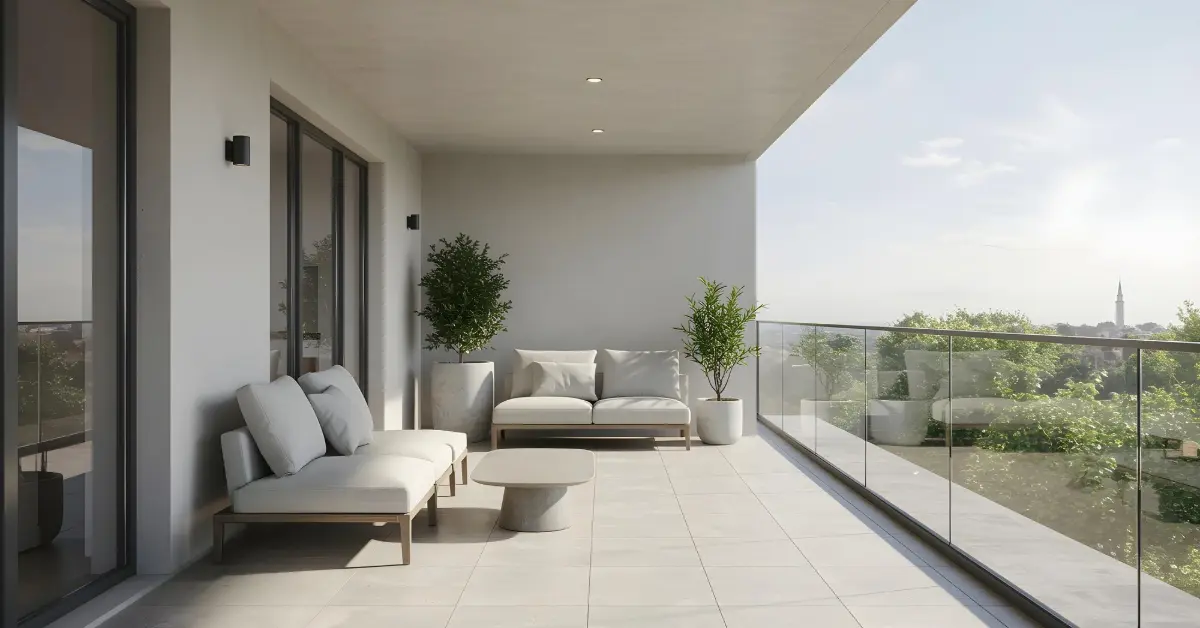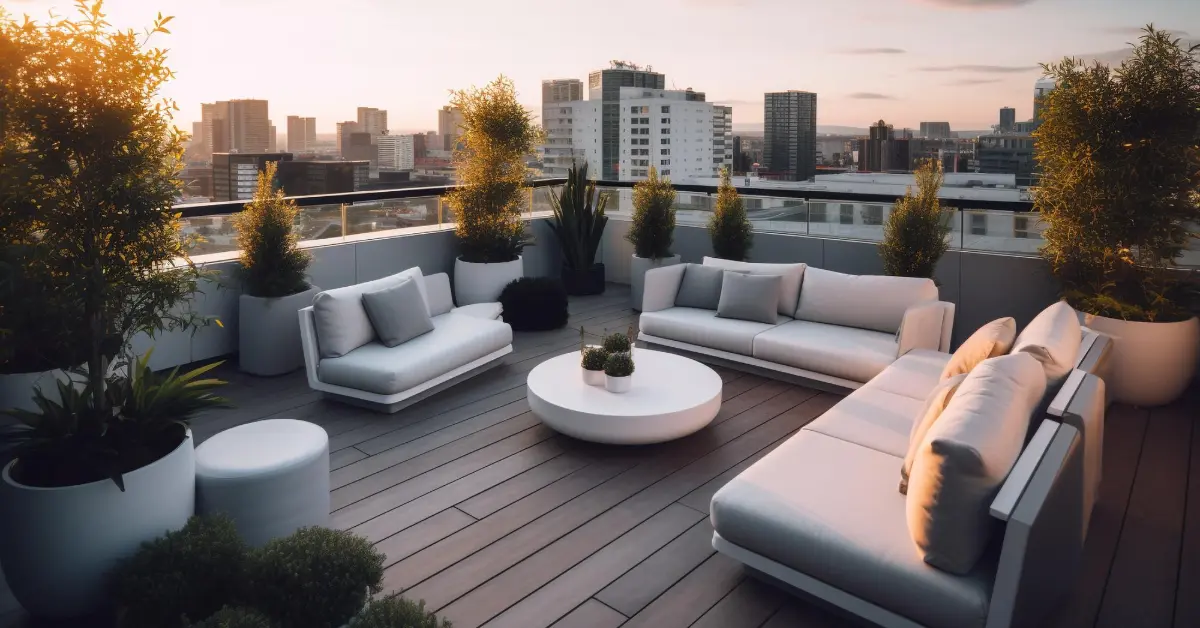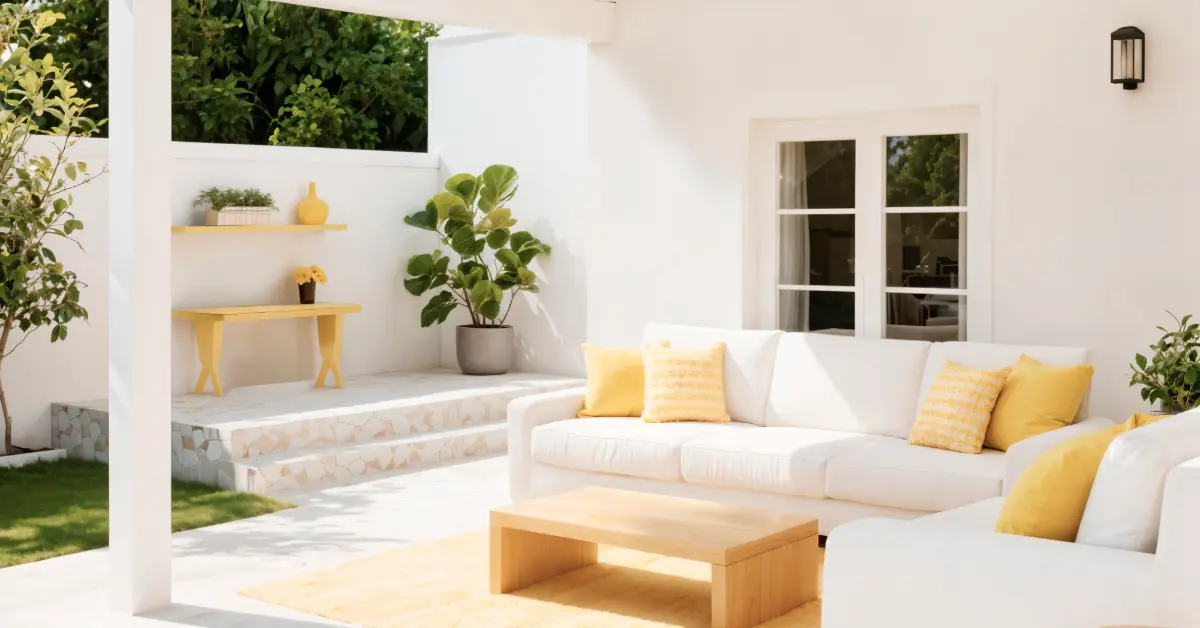Understanding the difference between a terrace and a balcony is essential for anyone buying, renting, or designing a home in the UAE. While both offer valuable outdoor space, the terrace vs balcony comparison highlights how they differ significantly in terms of size, structure, location, and usage. These differences impact not only lifestyle but also maintenance, privacy, and property value. Ground-level terraces are especially popular in family-friendly communities in Dubai, where outdoor space is highly valued.
- Terrace vs Balcony: Core Differences
- Size Comparison
- Location & Elevation
- Access & Entry
- Construction & Design
- Typical Uses
- Outdoor Space Comparison: Balcony or Terrace?
- Design, Safety & Maintenance Considerations
- Which Should You Choose?
- Key Takeaways
- FAQs

Terrace vs Balcony: Core Differences
Terraces and balconies are both prized outdoor features in UAE homes, but they differ significantly in terms of design, accessibility, and usage. A terrace is typically larger, more versatile, and can be located at ground level, podium level, or on a rooftop, making it suitable for whole outdoor living and entertaining. A balcony, by contrast, is a smaller elevated platform attached directly to a specific room, offering a more private extension of indoor space.
Beyond size and elevation, the two also vary in terms of privacy, structural requirements, and maintenance needs. Terraces offer greater design freedom, allowing for features such as seating areas, greenery, and dining zones. In contrast, balconies must adhere to stricter structural rules due to their projection from upper floors. Residents should also follow UAE-approved balcony safety tips in Abu Dhabi or Dubai Municipality Rules for Balcony when placing furniture, plants, or décor on elevated platforms.
1. Size Comparison
When comparing terraces and balconies, size is one of the most noticeable differences. Terraces offer generous outdoor space suitable for a wide range of activities, while balconies are intentionally compact and designed for more personal, intimate use. Understanding how much outdoor room you need can help you determine which option fits your lifestyle and your home’s layout. Renters comparing outdoor spaces can refer to the Dubai renting guide for insights on tenancy rules and building regulations.
Terrace
Typically large, open outdoor areas that can span an entire rooftop, podium level, or ground-floor zone. Terraces can comfortably accommodate dining sets, outdoor lounges, or even small gardens.
Balcony
They are much smaller and more compact. Balconies generally fit 1–3 people and are ideal for private relaxation rather than hosting groups.
2. Location and Elevation
The positioning of a space within a building significantly affects how it is used. Terraces can exist at multiple levels, offering a sense of openness, while balconies are fixed high above the ground and provide elevated views. Understanding these placement differences helps you choose the outdoor space that best matches your lifestyle and privacy needs.

Terrace
May sit at ground level, on a podium, or on a rooftop. They can be attached to a home or completely freestanding.
Balcony
It is always elevated and attached to the building exterior, projecting from upper floors.
3. Access and Entry
How you enter the space also shapes how it will be used on a day-to-day basis. Terraces offer flexible access points suited for gatherings, while balconies provide a more private, room-attached extension of your home.
If you’re exploring different layouts, you can review the different types of apartments in the UAE to understand how terraces and balconies fit into modern building designs.
Terrace
It can be accessed from common areas, a living room, or directly from outdoors. It doesn’t need to be linked to a specific room.
Balcony
It is always accessed from an internal room, usually a living room or bedroom.
4. Construction and Design
The structural requirements of terraces and balconies differ significantly, which affects how they are built, decorated, and maintained. Terraces offer more creative freedom, whereas balconies must adhere to strict engineering and safety standards.

Terrace
It is built using tiles, pavers, concrete, artificial grass, or wooden decking as terraces sit on stable surfaces, and design flexibility is high.
Balcony
Structural extension of the building façade. Supported by cantilevered beams or exterior brackets, with strict safety and weight regulations.
5. Typical Uses
Due to their size and layout, terraces and balconies naturally lend themselves to various lifestyle uses. Terraces offer space for full outdoor living, while balconies provide a more intimate setting, suited for everyday personal enjoyment.
Terrace
Entertaining guests, outdoor dining, barbecues, gardening, sunbathing, and recreation.
Balcony
Private relaxation, enjoying views, morning coffee spots, or small potted plants.
Outdoor Space Comparison: Balcony or Terrace?
Although terraces and balconies are both outdoor extensions of a home, they differ significantly in size, structure, and how they’re used. Terraces provide open, versatile spaces suitable for hosting gatherings or creating outdoor lifestyle zones, while balconies offer a more compact, elevated retreat connected to a single room.
Understanding these distinctions helps homeowners and renters decide which outdoor feature best suits their space, privacy needs, and day-to-day living habits.
| Feature | Terrace | Balcony |
| Size | Large, spacious | Small, compact |
| Location | Ground level, podium, or rooftop | Attached to the upper floors |
| Access | Multiple entry points | From an adjoining room |
| Construction | Paved/tiled/wood, attached or standalone | Cantilevered or bracket- |
| Regulations | Fewer structural limits | Stricter due to elevation |
| Cost | Higher due to size | Lower overall |
| Best For | Hosting, gardening, recreation | Private relaxation |
Design, Safety & Maintenance Considerations
Designing a terrace or balcony requires striking a balance between aesthetics and safety, as well as long-term maintenance. Because each structure has different size limitations and load capacities, the materials, furniture, and décor you choose should be appropriate for the space. Terraces offer more flexibility for landscaping, shading, and outdoor furniture, while balconies require stricter safety compliance and lighter-weight elements.
Understanding these differences helps you create an outdoor area that is both stylish and safe, whether you’re planning a rooftop lounge or a compact private corner.
Moreover, if you’re comparing different property types, you can explore outdoor space availability and building styles through Property Finder’s Community Insights, which highlight how various neighbourhoods in the UAE incorporate terraces, balconies, and other lifestyle features.

Terrace Design Tips
- Use durable outdoor-friendly materials such as stone tiles, porcelain, or timber decking.
- Incorporate greenery, such as planters, vertical gardens, or small trees.
- Add shading (pergolas, umbrellas, or canopies) for daytime comfort.
- Maintenance varies depending on the materials—wood requires sealing, while tiles need periodic cleaning.
Balcony Design Tips
- Install railings that meet safety and privacy standards.
- Choose compact furniture pieces such as bistro tables or foldable chairs.
- Ensure plants or décor adhere to weight limits.
- Schedule periodic structural checks for railings, brackets, or beams.
Which Should You Choose?
Choosing between a terrace and a balcony ultimately comes down to how you plan to use your outdoor space. Terraces are the better fit for residents who love entertaining, gardening, or creating a complete outdoor living zone, thanks to their generous size and design flexibility. Balconies, on the other hand, are ideal for those who prefer privacy, scenic views, and minimal upkeep.
- A terrace is suitable for hosting, dining, and landscaping, but generally involves higher costs and more maintenance.
- A balcony is ideal for quiet relaxation and day-to-day use, offering lower maintenance but stricter safety requirements.
Pet owners may prefer terraces for added outdoor space; you can also explore pet-friendly buildings in Dubai to see which developments support outdoor-space living.
Key Takeaways
Terraces and balconies differ mainly in size, location, and function. Terraces are larger, often located on the ground floor or rooftop, and are ideal for entertaining, gardening, and outdoor dining. Balconies, on the other hand, are smaller, elevated platforms attached to a building, best suited for private relaxation and enjoying views. While terraces offer more versatility and usable space, balconies provide intimacy and easier maintenance. Safety and structural regulations are also stricter for balconies due to their elevated position. Ultimately, the right choice depends on your space requirements, lifestyle needs, and budget.
FAQs
Yes, terraces can be built on rooftops and may span the entire top surface of a building.
Yes, balconies must be connected to an internal room and accessed through it.
Terraces are better suited for gatherings due to their larger size and flexibility.
Balconies need regular structural and safety inspections; terraces require more surface maintenance depending on size and materials.
Generally, yes, terraces cost more because of their larger footprint and construction requirements.
Generally, yes. Because terraces offer more usable space, they often contribute more to resale appeal, especially in rooftop or podium-level units.
In most cases, no. Enclosing a balcony typically requires approval from the building management and Dubai Municipality, and it is often restricted for safety and façade consistency.
Yes, terraces provide more room for play areas, outdoor dining, and gardening, making them popular among families in villas, townhouses, and podium-level apartments.
Balconies usually require less maintenance, while terraces need more frequent cleaning and care due to their size and exposure.